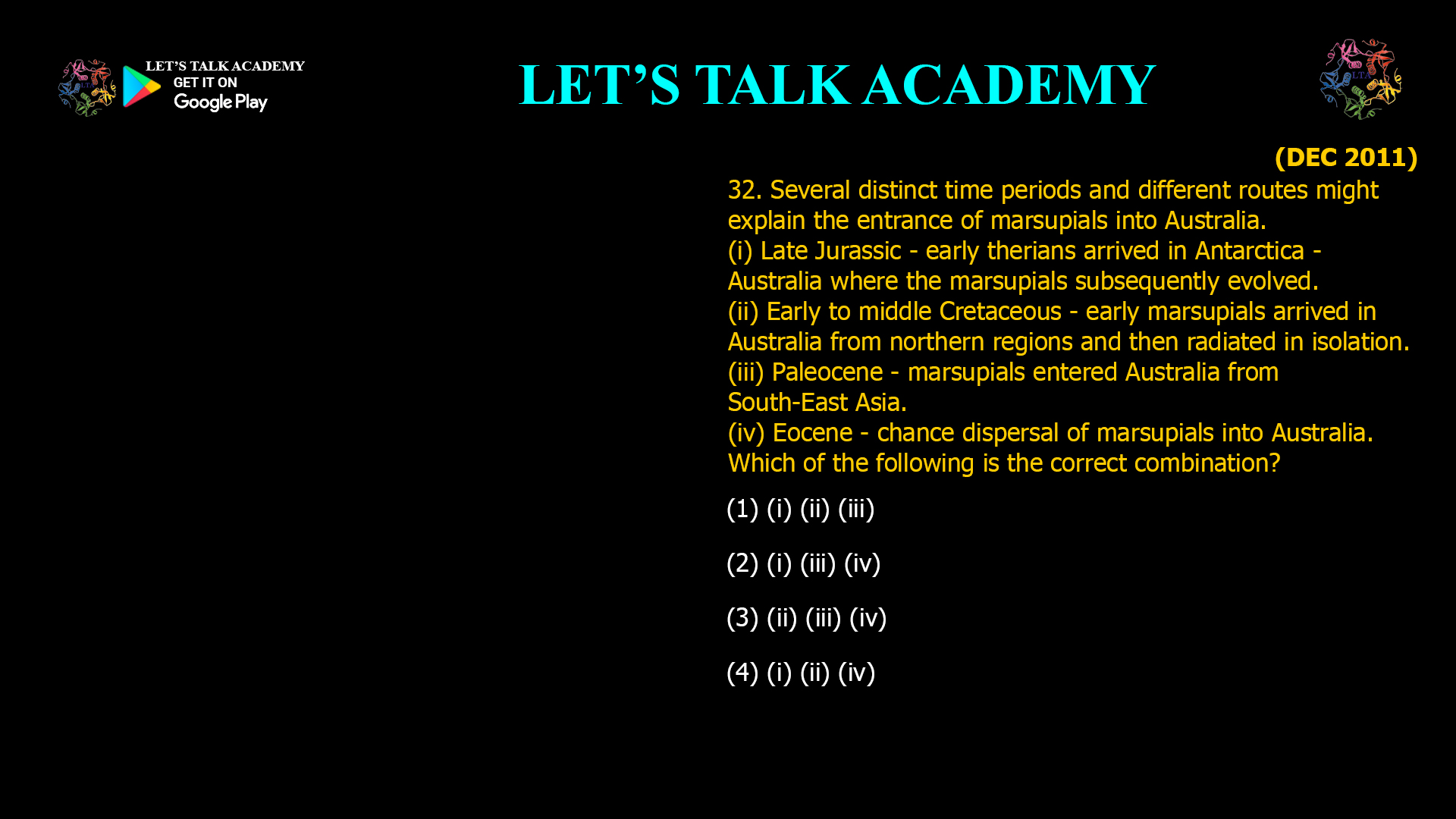- Several distinct time periods and different routes might explain the entrance of marsupials into Australia.
(i) Late Jurassic – early therians arrived in Antarctica – Australia where the marsupials
subsequently evolved.
(ii) Early to middle Cretaceous – early marsupials arrived in Australia from northern regions and then radiated in isolation.
(iii) Paleocene – marsupials entered Australia from South-East Asia.
(iv) Eocene – chance dispersal of marsupials into Australia.
Which of the following is the correct combination?
(1) (i) (ii) (iii) (2) (i) (iii) (iv)
(3) (ii) (iii) (iv) (4) (i) (ii) (iv)Tracing the Arrival of Marsupials in Australia: Exploring Geological Timeframes and Migration Routes
Marsupials are among the most distinctive groups of mammals, best known for their unique reproductive strategy involving pouches. Today, Australia is home to the richest diversity of marsupials, but their origins and the timing of their arrival on this isolated continent have long intrigued scientists. Several hypotheses propose different geological periods and migration routes explaining how marsupials came to Australia. This article examines these theories, highlighting the most plausible combinations based on current scientific understanding.
The Puzzle of Marsupial Migration
Marsupials originated in the Northern Hemisphere but are now most diverse in Australia and the Americas. Understanding how they reached Australia involves piecing together fossil evidence, plate tectonics, and biogeographic data. The key question is: When and by which routes did marsupials enter Australia?
Four main hypotheses propose different timeframes and pathways:
-
Late Jurassic – Early Therians via Antarctica to Australia
This theory suggests that early therians (the group including marsupials and placentals) arrived in Antarctica during the Late Jurassic, then migrated to Australia, where marsupials evolved in isolation. -
Early to Middle Cretaceous – Early Marsupials from Northern Regions
According to this idea, marsupials migrated from northern continents to Australia during the Early to Middle Cretaceous, then radiated in isolation. -
Paleocene – Marsupials Enter Australia from South-East Asia
This hypothesis posits that marsupials dispersed from South-East Asia into Australia during the Paleocene. -
Eocene – Chance Dispersal of Marsupials into Australia
This view suggests a chance dispersal event during the Eocene, possibly involving rafting or island hopping, allowing marsupials to reach Australia.
Evaluating the Migration Routes and Timeframes
Late Jurassic to Early Cretaceous Route via Antarctica (Hypotheses i and ii)
The Late Jurassic to Early Cretaceous period (approximately 160 to 100 million years ago) was a time when the supercontinent Gondwana was intact or beginning to break apart. Australia, Antarctica, and South America were connected, creating a land bridge that could facilitate mammalian migration.
-
Fossil evidence supports that marsupials diverged from placental mammals roughly 90 million years ago, consistent with this timeframe.
-
Marsupials likely evolved initially in the Northern Hemisphere but expanded southward.
-
Antarctica acted as a crucial corridor for marsupials moving into Australia before the continents fully separated.
This route is widely supported because it aligns with geological data showing Australia and Antarctica remained connected until about 45 million years ago, allowing terrestrial fauna to disperse.
Paleocene and Eocene Dispersal Hypotheses (Hypotheses iii and iv)
The Paleocene (66–56 million years ago) and Eocene (56–34 million years ago) epochs followed the mass extinction that wiped out the non-avian dinosaurs. During this time:
-
Australia began drifting northward but was still close enough to Antarctica to allow faunal exchange.
-
Some scientists propose marsupials could have entered Australia from South-East Asia during the Paleocene, but this is less supported due to the lack of fossil evidence and geographic barriers.
-
The Eocene chance dispersal hypothesis suggests rare events like rafting could explain marsupial arrival, but this is considered less likely given the established land connections.
The Most Supported Combination
Based on current scientific consensus and fossil records, the most plausible combination involves:
-
(i) Late Jurassic – early therians arrived in Antarctica – Australia where marsupials subsequently evolved.
-
(ii) Early to middle Cretaceous – early marsupials arrived in Australia from northern regions and then radiated in isolation.
-
(iv) Eocene – chance dispersal of marsupials into Australia.
This combination recognizes the primary migration through Antarctica during the Late Jurassic to Cretaceous, with a possible minor dispersal event in the Eocene.
The Paleocene dispersal from South-East Asia (iii) is generally considered less likely due to geographic and fossil constraints.
Therefore, the correct combination is:
(4) (i), (ii), and (iv)
Why This Combination Makes Sense
-
Geological Evidence: Australia and Antarctica’s connection during the Late Jurassic to Eocene provided a continuous land route for marsupials.
-
Fossil Record: Oldest marsupial fossils date back to the Cretaceous in the Northern Hemisphere, with later fossils in Antarctica and Australia.
-
Biogeography: Australian marsupials share close affinities with South American and Antarctic marsupials, supporting a southern migration route.
-
Isolation: Australia’s eventual separation from Antarctica in the Miocene (~45 million years ago) led to marsupials evolving in isolation, explaining their unique diversity.
Conclusion: The Journey of Marsupials to Australia
The migration of marsupials into Australia is best explained by a combination of routes and time periods. Early therians likely reached Antarctica and Australia during the Late Jurassic and Early Cretaceous, followed by radiation in isolation. A chance dispersal during the Eocene may have supplemented this migration. The hypothesis of Paleocene migration from South-East Asia lacks strong evidence.
This migration story highlights how continental drift, climate change, and chance events shaped the unique fauna of Australia. Understanding these patterns enriches our knowledge of evolution and biogeography, illustrating the complex journey of life across ancient Earth.
This synthesis of geological and biological evidence supports the view that marsupials’ arrival in Australia was a multifaceted process primarily involving southern land connections rather than northern dispersal routes.
-



